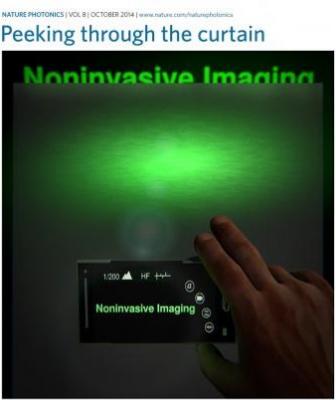High-resolution imaging and light control through highly scattering media, such as tissues and fog, are fundamental challenges with significant implications for a variety of applications, including microscopy, cell and molecule manipulation, and astronomy.
Recent breakthroughs, such as imaging through biological tissues and looking around corners, have been achieved using wavefront-shaping approaches. However, these methods typically require an implanted guide-star for determining the wavefront correction, controlled coherent illumination, and often raster scanning of the shaped focus. Alternative computational approaches exploit speckle correlations but are limited to small two-dimensional objects within the 'memory-effect' correlation range.
Image-guided wavefront-shaping
We have recently developed a new concept called image-guided wavefront-shaping, which enables non-invasive, guide-star-free, wide-field, incoherent imaging through highly scattering layers without the need for illumination control. The wavefront correction is determined for objects larger than the memory-effect range by blindly optimizing image quality metrics. We have demonstrated imaging of extended objects through highly scattering layers and multi-core fibers, paving the way for non-invasive imaging in various applications, from microscopy to endoscopy.
We are currently working on expanding this concept to include computational techniques for fast imaging through highly scattering media, with the aim of enabling real-time applications.
Image-guided computational holographic wavefront shaping
In a recent work, we developed a computational framework for high-resolution imaging through scattering media without requiring guide stars or physical wavefront shaping devices like spatial light modulators (SLM). By leveraging holographically recorded random illuminations and advanced computational optimization, the method reconstructs high-quality images through several scattering layers. This approach shifts the burden from physical hardware to digital computation, using automatic differentiation to optimize wavefront corrections virtually.
The figure below illustrates the power of this approach: the left image shows the uncorrected view through a scattering medium, while the right image displays the computationally reconstructed image of onion skin cells.
Fluorescence microscopy through scattering layers by a virtual incoherent reflection matrix analysis
Optical-resolution fluorescence imaging through and within complex samples presents a major challenge due to random light scattering, with substantial implications across multiple fields. While considerable advancements in coherent imaging through severe multiple scattering have been recently introduced by reflection matrix processing, approaches that tackle scattering in incoherent fluorescence imaging have been limited to sparse targets, require high-resolution control of the illumination or detection wavefronts, or require a very large number of measurements. In a recent work, we presented an approach that allows the adaptation of well-established reflection matrix techniques to scattering compensation in incoherent fluorescence imaging. We experimentally demonstrated that a small number of conventional wide-field fluorescence microscope images acquired under unknown random illuminations can effectively be used to construct a virtual fluorescence-based reflection matrix. Processing this matrix by an adapted matrix-based scattering compensation algorithm allows reconstructing megapixel-scale images from <150 acquired frames, without any spatial light modulators or computationally intensive processing.
Previous group works:
- Haim, Omri, Boger-Lombard, Jeremy, and Ori Katz. "Image-guided computational holographic wavefront shaping". Nature Photonics (2025).
- Weinberg, Gil, Elad Sunray, and Ori Katz, “Noninvasive megapixel fluorescence microscopy through scattering layers by a virtual incoherent reflection matrix”, Science Advances 10 (47), eadl5218 (2024).
- Yeminy, Tomer, and Ori Katz. "Guidestar-free image-guided wavefront shaping". Science Advances 7.21 (2021).
- Stern, Galya, and Ori Katz. “Noninvasive focusing through scattering layers using speckle correlations”. Optics Letters 44.1 (2019).
- Boger-Lombard, Jeremy, and Ori Katz. “Passive optical time-of-flight for non line-of-sight localization”. Nature Communications 10 (2019).
- Salhov, Ofer, Gil Weinberg, and Ori Katz. “Depth-resolved speckle-correlations imaging through scattering layers via coherence gating”. Optics letters 43.22 (2018).
- Katz, Ori, Eran Small, and Yaron Silberberg. “Looking around corners and through thin turbid layers in real time with scattered incoherent light”. Nature Photonics 6 (2012).






